Video: Iraq Vet Vince
Emanuel Speaking on War
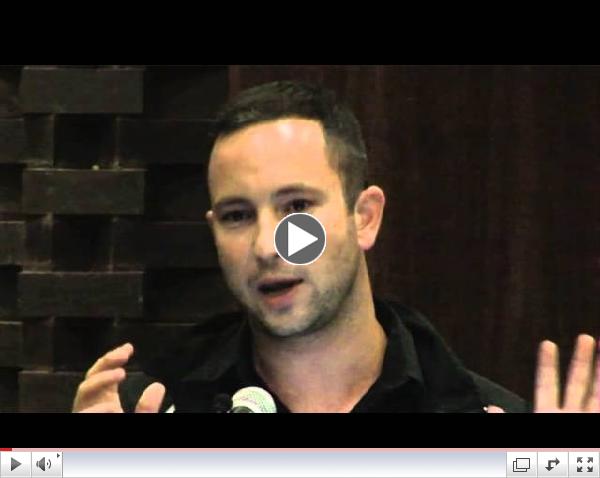 | | US Activist and Iraq War Veteran Vincent Emanuele Speaks Out |
|
|
Quick Links...
CCDS Discussion |
 The new annual edition of our journal of discussion and analysis is now out. More than 130 pages, it includes 20 articles on organizing, racism and the right. Cost is $10 plus shipping. Or get one by becoming a sustainer. Click the title to buy it directly. The new annual edition of our journal of discussion and analysis is now out. More than 130 pages, it includes 20 articles on organizing, racism and the right. Cost is $10 plus shipping. Or get one by becoming a sustainer. Click the title to buy it directly.
|
New Issue of Mobilizer

Check out what CCDS has been doing...
|
Blog of the Week: Daniel Ellsburg on Why Edgar
Snowden Made the Right Call
|

Edited by Carl Davidson Revolutionary Youth the the New Working Class: The Praxis Papers, the Port Authority Statement, the RYM Documents and other Lost Writings of SDS
Changemaker, 273pp, $22.50
For the full contents, click the link and view 'Preview' under the cover graphic.
|
|
By Randy Shannon, CCDS

"Everyone has the right to work, to free of employment, to just and favorable conditions of work and to protection against unemployment."
- United Nations Universal Declaration of Human Rights, December 10, 1948
I. Introduction
The "Great Recession" that began in 2007 has caused the greatest percent of job losses since the Great Depression of 1929. This crisis is the end of an era of unrestrained 'neo-liberal' capitalism that became public policy during the Reagan administration. The crisis marks a new level of instability with the growth of a global financial elite that targeted US workers and our trade unions after World War II.
|
|
Order Our
Full Employment Booklets
 |
...In a new and updated 2nd Edition
Capitalism may well collapse under its own excesses, but what would one propose to replace it? Margaret Thatcher's mantra was TINA...There Is No Alternative. David Schweickart's vision of "Economic Democracy" proposes a serious alternative. Even more fundamentally, it opens the door to thinking about alternatives. His may or may not turn out to be the definitive "successor system," but he is a leader in breaking out of the box. |
We Are Not What We Seem:
Black Nationalism and Class
Struggle in the American Century
By Rod Bush, NYU Press, 1999
|
 A Memoir of the 1960s A Memoir of the 1960s
by Paul KrehbielAutumn Leaf Press, $25.64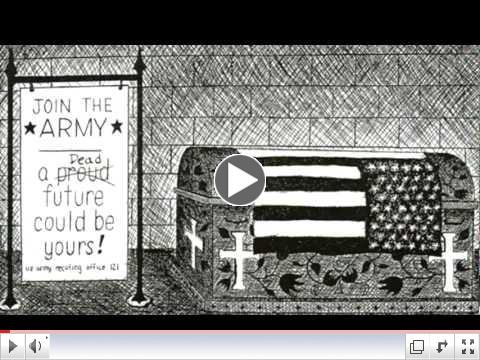 | | Shades of Justice Video: Bringing Down a President, Ending a War |
|

Essays on Mondragon, Marx, Gramsci
and the Green and Solidarity Economies |
Solidarity Economy:What It's All About

Edited by Jenna Allard, Carl Davidson and Julie Matthaei
Buy it here...
|

- Foreword by Susan Brownmiller
- Preface by Ken Wachsberger
$37.50 + $6 shipping
|
|
Discussion Documents for a Militant Movement
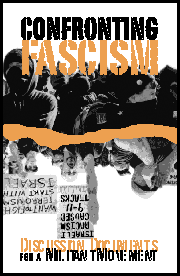
By Don Hamerquist
|
|
|
|
An Invitation to CCDSers and Friends...
 Ruling Class Playing with Social Dynamite
We're the Committees of Correspondence for Democracy and Socialism...Do you have friends who should see this? Pass it on...Do you have a blog of your own? Others you love to read every day? Well, this is a place where you can share access to them with the rest of your comrades. Just pick your greatest hits for the week and send them to us at carld717@gmail.com!
Most of all, it's urgent that you defend voter rights, plan for 2014 races now, oppose austerity, support the Congressional Progressive Caucus' 'Back to Work Budget' and end the wars! We're doing more than ever, and have big plans. So pay your dues, make a donation and become a sustainer. Do it Now! Check the link at the bottom...
|
Prison Insurgency: California Officials say 30,000 Inmates Refuse Meals

By Paige St. John Los Angeles Times
July 8, 2013 - California officials Monday said 30,000 inmates refused meals at the start of what could be the largest prison protest in state history.
Inmates in two-thirds of the state's 33 prisons, and at all four out-of-state private prisons, refused both breakfast and lunch on Monday, said corrections spokeswoman Terry Thornton. In addition, 2,300 prisoners failed to go to work or attend their prison classes, either refusing or in some cases saying they were sick.
The corrections department will not acknowledge a hunger strike until inmates have missed nine consecutive meals. Even so, Thornton said, Monday's numbers are far larger than those California saw two years earlier during a series of hunger strikes that drew international attention.
Despite the widespread work stoppages and meal refusals, Thornton said state prisons operated as usual through the day. "Everything has been running smoothly," she said. "It was normal. There were no incidents."
The protest, announced for months, is organized by a small group of inmates held in segregation at Pelican Bay State Prison near the Oregon border. Their list of demands, reiterated Monday, center on state policies that allow inmates to be held in isolation indefinitely, in some cases for decades, for ties to prison gangs.
Though prison officials contend those gang ties are validated, the state last year began releasing inmates from segregation who had no evidence of gang-related behavior. Nearly half of those reviewed have been returned to the general population.
The protest involves the same issues and many of the same inmates who led a series of protests in California prisons two years ago. At the height of those 2011 hunger strikes, more than 11,600 inmates at one point refused meals. The correction department's official tally, which counts only those inmates on any given day who have skipped nine consecutive meals, never rose above 6,600.
Prison protests begin with list of demands
Inmate leaders at California's supermax prison near Oregon on Monday launched what they said is a statewide protest of policies that hold prisoners in isolation indefinitely, a continuance of the same grievances behind statewide hunger strikes two years ago.
"California officials have refused to meaningfully negotiate with us over our reasonable demands," the four inmates said in a statement provided to The Times on Monday by their lawyers. The document includes a list of eight "demands," starting with a five-year limit on the time prisoners can be held in isolation in Segregated Housing Units, and a 90-day limit on the time inmates can be kept in the more temporary Administrative Segregation cells.
There are 4,527 inmates being held in "segregation" cells at four state prisons, including 1,180 at Pelican Bay State Prison, where the protest leaders are based. Inmates can be held indefinitely in the isolation units and are required to spend almost all of their time within the Spartan cells, with reduced privileges, access to outside food, visits or rehabilitation programs.
For months, the Pelican Bay inmate leaders have called for a hunger strike and work stoppage to begin Monday. ...(Click title for more)
|
|

By Frank Koller
PBS Newshour
In a 2012 Making Sen$e report, "Man vs. Machine," Paul Solman examines the future of the American worker:
Paul Solman: "Man vs. Machine." Long the staple of science fiction, the "end of work" now beckons as reality. Journalist, author and Friend Of Making Sen$e (FOM$) Frank Koller attended a conference on the debate at Cornell University recently. He was accommodating enough to file this report.
Koller's book, "Spark," fired our renewed interest in the remarkable Rust Belt manufacturing firm Lincoln Electric, on which we reported in the early 1990s and again in 2011, with Koller prominently featured. A firestorm of comments followed, which we summarized on the Making Sen$e Business Desk. Finally, Koller himself weighed in. Now for Koller's take on the future-of-work debate.
Frank Koller: Story One goes like this: "If you're talking about 100 years from now, all jobs will be gone ... including the creative ones."
Story Two sounds like this: "The recovery of jobs is not all that bad ... it's moving in the right direction."
Okay, are these two folks living on the same planet? Yes. In fact -- amazingly and thankfully -- they were in the same room, sharing ideas about changes in the American workplace brought about by new technologies.
Four years after the Great Recession officially ended, millions of Americans are still unemployed and millions more remain underemployed. (For most, the distinction is unimportant: they're all hurting.)
The economy has been growing slowly, but corporate profits have soared as businesses have embraced new labor-saving technologies, doing everything and anything they can to avoid hiring permanent workers, leaving governments from Washington to Smallville struggling to figure out how to ensure the survival of America's beleaguered middle class.
To be accurate, it's not just governments who are struggling to understand what's going on. Almost everyone -- in business, technology, finance, labor, academia and society at large -- seems unsure about what's happening, which makes figuring out what to do next exceedingly hard.
This challenge has been made more difficult because there have been very few times when a truly broad group of people from opposing corners of the economic landscape has come together to share their experiences, their worries and their expectations for what is clearly a national crisis.
So, to help get a dialogue going, Cornell University's School of Industrial and Labor Relations recently brought together 40 leading economists, policy makers, engineers, bankers, corporate executives, social scientists, philanthropists, journalists and statisticians for a day-long exploration of how technology is shaping -- or misshaping -- the American workplace.
Coming up with answers was not the goal: Cornell's belief was that searching for consensus in a one-day meeting would be futile. Initially, I wondered about the utility of that, given the gravity of the economic challenge facing the country. But it was a good decision. The range of views on what's happening was so wide -- and surprising -- that reaching realistic solutions would have been, well, unrealistic. Precisely because this kind of a meeting has been so rare, the meeting imposed the Chatham House Rule on attendees: we could talk afterwards about what was said, but not about who said it. (I later asked some of those who attended if I could quote them directly; almost all said yes.) If I had to sum up a fascinating day -- well, let's save that for the end, after you've seen the amazing diversity of views on the future of work.
Here's perhaps the fundamental question about what's going on in the American economy as it struggles to recover from the Great Recession: "How is this recovery different from other recoveries?" Or is it?
To put it in economese, is the persistently high level of unemployment a result of cyclical factors (the traditional ups and downs of economic growth) or structural factors (new game-changing technologies, dramatic shifts in the global economy)? The NewsHour has covered this debate several times, including economists duking it out in one recent instance.
From one decades-long leading student of the American economy came a succinct one-liner in favor of cyclicality: "This isn't a jobless economic recovery as everyone insists on calling it; it's simply just not yet a recovery."
In other words, as painful as the waiting certainly is, the economy will heal -- and once again, create jobs -- in time.
"Brace yourselves," countered Eric Brynjolfsson, from MIT's Sloan School, co-author of "Race Against the Machine," a much-talked-about recent book which argues that the introduction of new transformative technologies has only just begun, and that we're dangerously unable to perceive what's actually going to happen. ...(Click title for more)
|

By Jerriann Sullivan
Orlando Sentinel
July 10, 2013 - Deputies from South Florida have released a public-service announcement urging possible protesters to remain peaceful after the jury decides whether George Zimmerman is guilty of murder in the fatal shooting of Trayvon Martin.
The Broward County Sheriff's Office website says deputies have been "working closely with the Sanford Police Department and other local law enforcement agencies" to create a "coordinated a response plan in anticipation of the verdict."
Sanford Police Chief Cecil Smith, however, said his agency didn't know about the video and has not coordinated response plans with Broward.
"We...have had really no contact with Broward County in regards to setting up plans and structures in response to anything," Smith said.
Broward Sheriff's officials did not return calls from the Sentinel Wednesday seeking comment about the lack of coordination between the agencies.
Sanford police have worked closely with the Seminole County Sheriff's Office to develop plans on how to respond to various incidents, Smith said, adding that he is doubtful violence will occur in Sanford - regardless of the verdict.
"What people called for a year ago has happened - an investigation into the shooting, George Zimmerman being charged, better training for law enforcement and the Department of Justice investigating the Sanford police department," Smith said. "Each of those things has been received."
Smith also said there has been a low turnout of protesters at the Seminole County courthouse throughout the trial so far.
The community "has put their trust into the judicial system and we ask that they keep putting their trust in the judicial system," Smith said.
Seminole Sheriff's spokeswoman Kim Cannaday said the agency, "had no hand in producing or releasing the video."
The 36-second video features law enforcement officials, kids from the Jason Taylor Foundation and James Jones of the Miami Heat. The participants shout "raise your voice, not your hands" and "let's give violence a rest, because we can easily end up arrested."
Broward County Sheriff Scott Israel said in a statement on the website that his agency has no information "about a specific event that might take place at the conclusion of the trial, but we encourage everyone to keep any protests peaceful."
Zimmerman is charged with second-degree murder in the fatal shooting of South Florida teenager Trayvon Martin in Sanford.
Trayvon of Miami Gardens was 17 when he was gunned down by Zimmerman, a Neighborhood Watch volunteer who claimed self-defense after the shooting in February 2012.
The trial is unfolding in Sanford and is drawing to a close....(Click title for more)
|
Why the Revival of US Labor
Might Start with Nonunion Workers
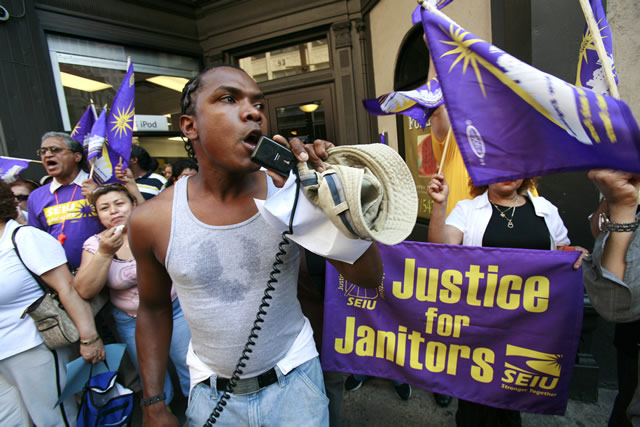
By Amy Dean Yes! Magazine
July 10, 2013 - For workers in America, it can be hard to know where to turn when a boss pays you late or not at all, doesn't provide benefits, or just yells at you for no good reason.
That's why a Working America, a "community affiliate" of the AFL-CIO that focuses specifically on nonunion workers, launched a website last month that makes it easy to get that kind of information. FixMyJob.com is a bit like WebMD, but instead of typing in your aches and pains, you tell it about problems at your workplace. Launched on June 5, the site has already garnered 5,000 visitors, according to Working America organizer Chris Stergalas.
After choosing from a comprehensive list of workplaces and problems, visitors to FixMyJob.com get a set of resources and options for taking action. While unionization is a part of the solution for many problems, the site also informs workers about labor laws and instructs them on how to advance proposals to defend their rights. The site is a part of Working America's expanded new campaign to organize people in their communities in all 50 states, says Executive Director Karen Nussbaum.
In both online and offline campaigns, Nussbaum said, the aim of Working America is to reach beyond the workplace and rally support at the local level for a pro-labor agenda. Working America's list of priorities includes living wage laws, expanded health care, adequately funded public schools, and the protection of voting rights.
Before the launch of Working America, Nussbaum had served as founder and director of 9to5, National Association of Working Women; as director of the Women's Bureau of the U.S. Department of Labor; and as an advisor to former AFL-CIO president John Sweeney. I recently spoke with her about her vision for Working America, about FixMyJob.com, and about what the 50-state expansion means for the prospects of union revival.
Working America was founded in 2003 partly as an answer to the question of how to mobilize people who are not union members but would benefit from activism by and for working people. Nussbaum said that, from the beginning, her staff "concentrated on talking to workers in their communities." Scoring success in mobilizing blue-collar voters for electoral campaigns, the organization created a foundation of members, and it is increasingly attempting to mobilize them around broader issues like working conditions, paid sick leave, and the right to join unions.
She added that the ultimate goal of Working America is "finding the connections with collective bargaining." But she's experimenting with different ways of organizing that might lead there. "It's about taking whatever path opens on the way."
In past years, Working America focused on battleground states during elections. But regional and statewide labor federations have pushed the organization to expand to all 50 states over the next five years. At first, Nussbaum said, that goal seemed "preposterous," but she has come to embrace it. Ultimately, she said, she appreciated the strategic value of supporting local labor structures as they connect with community allies and work on issues that go beyond a single workplace....(Click title for more)
|
|
July 5, 2013 -- Links International Journal of Socialist Renewal -- Below are a number of articles from the left on the massive protests and military intervention that toppled the government of Mohamed Morsi in Egypt on July 3, 2013.
* * *
On the fall of Morsi -- live from Cairo
The following interview with Egyptian activist Hannah Elsisi appeared at the IS Network on July 3, 2013.
Is today a victory for revolution or counterrevolution?
In a way, both. I'm currently sitting just off Tahrir Square with the woman who started "no to military trials", a musician, one of Cairo's most active street artists, and a novelist of the revolution. That is precisely the question we're discussing now - and we are split down the middle. Half of us see this as a victory for the revolution and the other half as a victory for the counterrevolution - half as a step forward, half as a step backwards.
We're in this café, not the square, for a reason. We all feel and know that this is not the square we owned - as if we have no tangible place in it, despite knowing that we hold a "place" in the revolution.
Which half of the discussion are you in?
I'm in the optimistic half. Despite the fact that I've been most vocal about this unease for a few weeks now. Here's why.
Two years ago there were untold millions who either knew nothing of the revolution or had no time for it because they couldn't afford a minute off. Some resented it for stripping them of their privileges. Others even saw it as a return to the nice, "civilised" Egypt that they knew under British occupation and the monarchy!
What we have today is a mixture of the following. Several million Egyptians who previous took to the streets and remember the Muslim Brotherhood's lies, the blood they abandoned and the blood they themselves spilled. And many more, particularly outside the cities (where Mohamed Morsi still managed to fare well in the presidential elections after a six-month majority in parliament) have taken to the streets to protest their despair and disappointment in those they placed their faith in - not just now, but for a good 20 years.
However overarching this is a set of objections to the Muslim Brotherhood's rule that transcend class, religion, social occupation or revolutionary reference points.
What are the politics of the protests, and which tendencies dominate?
There is still a very strong discourse that Hosni Mubarak, and Anwar Sadat's regime before him, built over many years and for specific historical reasons. This discourse is built on both a rejection of "political Islam" without a rejection of Islam itself - indeed they entrenched Islamic discourse. At the same time they built a fairytale scenario where the Muslim Brotherhood and its members contain some transgenerational, transpolitical trait that causes them to rule ruthlessly and dictatorially, in a manner that is somehow worse than Sadat or Mubarak's dictatorships.
This is what motivates the majority of Egyptians on the streets today, though to varying levels. It is most extremely entrenched within the middle classes, and among Coptic Egyptians and older generations. Another motivating feature of the protests is a bourgeois notion of safety or "law and order" having disintegrated over the past few years, particularly under Morsi's rule.
However, the revolution itself is yet to explicitly take up an ideology or "leadership", and there are so many who have taken to the streets against Morsi simply to protest against their social and economic living conditions without any clear alternative in mind.
I feel the majority of those I encounter are there to remove the Muslim Brotherhood and their beards before they are out to remove the government. Here, I am in a minority. Beyond that though it seems as if most people are out to remove the government rather than wanting to install the military in power. Here, I am with the majority.
So the victory for the revolution today, in my opinion, shows the ruling class's weakness. Our prime fear should not be the military, as there are many who do not find the answer to their prayers there. The victory for the counterrevolution is quite frankly the threat of popular sectarian violence against a particular group of citizens that also happens to be the military's greatest political foe.
Can the rank and file of the army be split from the generals, or is this over optimistic?
The rank and file of the army will only consider such a situation if the majority or a large number of lay soldiers are forced to rule and govern, and deal with civilians. However, if the army can achieve what it had managed to not only in the shape of Morsi but also Sadat, Mubarak and Nasser - that is, rule under the auspices of revolutionary or liberal parliamentary governance - then there is no need for such direct rule, and as a consequence the circumstances will not necessarily be ripe for the institution's disintegration.
We've heard over the years about efforts to form a new, mass workers' party. How far have these efforts got?
Notions of class have nowhere in Egypt's history (save for short spells in the 1890s and 1920s-'30s) asserted themselves over political, cultural or socio-religious considerations. It is difficult to speak of a workers' party when we cannot speak of any more than 700,000 to a million Egyptians who identify with this notion at the most basic level.
Working class self-organisation has not ebbed one bit over the past five years, and under current circumstances there is nowhere for working-class consciousness to go but to develop further. However I say this to emphasise that while revolutionaries in Egypt use the slogan "general strike until the regime falls", and many agree, on the ground for all of us the main contradiction that needs explaining - or the main discourse we feel we lack - is a revolutionary narrative against the current government that stands on clear principle with respect to the military's role, while also rejecting the reactionary discourse against the Muslim Brotherhood specifically and supporters of political Islam more generally.
Right now I can hear the calls to prayer, and a march chanting "Egypt (clap clap clap) Egypt". And this is what I was referring to earlier in terms of the reactionary discourse of the revolt, making nationalist, militaristic sentiment the focus.
What is the left doing, and what does it have the capacity to do?
The left has the capacity to nurture and give confidence to those sections of the square who have no vested interest in military rule. We are working hard to keep chants and art against "el 3askar" (military rule) on the walls and on our tongues. The left will no doubt work hard to defend human rights and reject any calls for indiscriminate violence against any group. It will continue to build campaigns against sexual assault, and against the electricity shortages across Egypt's governorates. However uncomfortable we might sometimes feel, communists' place is on the streets, where the masses are....(Click title for more)
|
Johnny Depp's Tonto: Hollywood
Gets it Wrong But It Still Matters
 By Felicia Gustin By Felicia Gustin War Times
July 31, 2013 - Imagine for a moment what the reaction would be if Johnny Depp played the African American sidekick of a white cowboy. In Black face. Folks would pretty much go ballistic, right? What if Depp's grandmother told him that he had an African American ancestor somewhere back there? Would that make it okay? What if Depp said he wanted to reverse all the negative images of African Americans in cinema? Would that make it okay? What if the producers of the film donated proceeds from the premiere to the United Negro College Fund? What if there was an African American consultant working on the set? What if the movie provided roles for a dozen or so Black actors? Would any of these make it okay for Johnny Depp to don black face and portray an African American?
If not, why is okay for Johnny Depp to play Tonto in the Disney summer blockbuster The Lone Ranger? That question is being widely debated in mainstream media, progressive circles, and even in Indian Country.
Fortunately movie critics are panning The Lone Ranger so hopefully that will sink the movie before it's done too much damage. But despite this, we're still seeing the image of Johnny Depp as Tonto everywhere (don't even get me started on the dead bird on his head!) - from the cover of Rolling Stone to the TV talk show circuit to toy store shelves. A well-orchestrated media junket has Depp heavily promoting the film, while attempting to ward off criticisms of his portrayal of Tonto. Disney has pulled its usual marketing punches to coincide with the film's release so head on over to the Disney store where you too can pick up your Tonto action figure or even a Tonto boy's costume or headdress.
Some try to rationalize Depp's Tonto as just a figment of some white writer's imagination. But as Adrienne Keene writes at Native Appropriations.com, racial stereotyping is alive and well in most every depiction of Native peoples that we see today, Tonto included:
"Here's the thing. Yeah, Tonto is a fictional character, and there are plenty of white actors and actresses who play fictional characters, and we don't automatically assume that white people are fictional, so it shouldn't matter, right? We saw Natalie Portman as an evil-crazy-swan-human in the Black Swan, and we don't assume that Natalie Portman's character is representative of her, or all white people, in real life. But that, my friend, is white privilege at work. Everyday we see millions of representations of white people in varied and diverse roles. We see white actors as "real" people, as "fantasy" characters, and everything in between.
But for Native people, the only images that the vast, vast majority of Americans see are stereotypical in nature. You go to the grocery store and see plenty of smiling white children on cereal boxes, contrasted with the only readily recognizable Native image-the Land o' Lakes butter girl...There are also hardly any (if any) Native people in current, mainstream television shows. And this carries over even more strongly into Hollywood."
Let's also not forget the major professional sports teams brandishing their racist mascots while using the justification that they are "honoring" Native peoples. Remind me again how the Washington Redskins mascot honors Native Peoples? Or the Atlanta Braves or the Cleveland Indians or the recent Stanley cup winners, the Chicago Blackhawks?...(Click title for more)
|
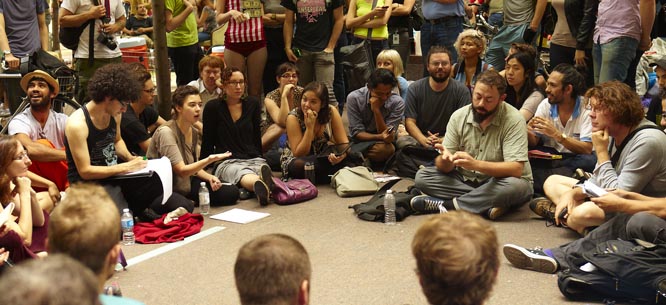
By Nikil Saval
Dissent Magazine / Summer 2013
Two Cheers for Anarchism: Six Easy Pieces on Autonomy, Dignity, and Meaningful Work and Play
by James C. Scott
Princeton, 2012, 198 pp.
The Democracy Project: A History, a Crisis, a Movement
by David Graeber
Spiegel & Grau, 2013, 352 pp.
Everyday Revolutions: Horizontalism and Autonomy in Argentina
by Marina A. Sitrin
Zed Books, 2012, 224 pp.
The financial crisis of 2007-2008 inspired a shallow but significant revival of Marxist analysis in academic life. A violent upsurge in theory, however, has corresponded to no particular insurrection in practice. If any radical left tendency has been responsible for inspiring action, the palm should go to Marxism's historic antagonist on the Left-anarchism. Wherever movements have been provoked against neoliberalism, black flags have tended to outnumber red. Autonomista and other kinds of left-libertarian thought were major currents running through movements in Greece and Spain. The cornerstone for the occupation of Zuccotti Park was laid by anarchists, who also developed the consensus procedures by which the movement participants made (or occasionally failed to make) decisions. Even where demands have seemed social democratic, many of the more creative and disruptive protests fueling them have been anarchist.
The ongoing confinement of Marxism to the academy is in some ways to be expected-it is, as David Graeber often quips, "the only great social movement that was invented by a Ph.D." More surprising, however, is the relative absence of anything like a professedly anarchist viewpoint-whether anarchist social science or anarchist literary theory-in theoretical work. It's not the case that anarchists, with classic bodies of work and debates on natural selection and evolution as a model for cooperation (Kropotkin), the nature of revolutionary action (Bakunin), or the origins of private property (Proudhon), have nothing to say about matters long the province of Marxists. Still, anarchism seems to be chiefly visible and successful in the world of activism, rather than in that of social thought. It's as if (to cite a point also made by Graeber) Marxists and anarchists have submitted to a tacit division of labor: you handle the organizing, we'll handle the theory.
But it appears as if the more recent anarchist movements are beginning to leave their mark, with a spate of books that attempt to consolidate what may be a kind of anarchist theory for the twenty-first century. Like Marxist analysis, which often seeks to unmask the real tendencies of history beneath the surface of the quotidian, anarchist theory, too, has an unmasking strategy: it sees fervent activity where one might be tempted to see stasis and homogeneity. What looks like consent is actually resistance; what looks like capitalism's domination over everything actually conceals systems of mutual aid. Anarchist theory doesn't just advocate anarchism; it rather reveals that, beneath everything, we're more anarchist than we thought.
James C. Scott, a political scientist and anthropologist at Yale, has pursued anarchist themes, mostly in Southeast Asian history, for more than three decades. Though not an anarchist himself (he has described himself as a "crude Marxist, emphasis on the 'crude'"), his analysis of protest movements is ecumenical in an anarchist way, acknowledging all kinds of disruption as "political." And though he discusses inequalities of economic distribution, the focus of his disapprobation is usually unchecked exercise of state power, attempts by states at social engineering, something that distances him from more traditional socialists. In Scott's hands, anarchism isn't so much a socio-political doctrine as an anti-authoritarianism practiced, unselfconsciously, in everyday life-a means of insubordination running across societies everywhere.
Scott's Two Cheers for Anarchism (its title echoes E.M. Forster's Two Cheers for Democracy, and, less happily, Irving Kristol's neoconservative Two Cheers for Capitalism), a rambling bagatelle of a book, distills these arguments. Made up of a number of short prose sections, which the author self-exculpatorily dubs "fragments," Two Cheers recapitulates themes from Scott's previous books: that resistance takes a number of forms, very often hidden, and that states tend to suppress practical knowledge and human self-organization. For Scott, social movements gain influence through their will to disruption and the violent reactions disruption inspires-a rejoinder to moderates obsessed with policing movements internally. Scott holds up local or "vernacular" knowledge as superior to seemingly more enlightened, technocratic exercises of power. Local names for streets, regional languages, musical traditions, land-use practices: all are forms of practical knowledge that nation-states find "illegible" and seek to homogenize in the interests of hierarchical coordination, often destructively. Scott describes the failed attempts of scientific forestry to introduce standardized tree growth as an example of experts misreading the vernacular landscape.
Scott's book recasts anodyne liberal accounts of the past as evidence that movements were more anarchic than we remember. The reason that we recognize the name-brand organizations of the black freedom movement, such as the NAACP or SNCC is because, Scott tells us, "organized progressive interests achieve a level of visibility and influence on the basis of defiance that they neither incited nor controlled." Protests exceed the grasp of the organizations: "The widespread voter-registration drives, Freedom Rides, and sit-ins were the product of a great many centers of initiative and action....The enthusiasm, spontaneity, and creativity of the cascading social movement ran far ahead of the organizations wishing to represent, coordinate, and channel it." These sentences could equally describe Occupy Wall Street, which brought to birth many different forms of activity and organizations only after the start of the encampment-protest.
The difficulty is that, in Scott's hands, the failure of states tends to become axiomatic, whereas the failure of social movements hardly registers. Thus, he admits in one section that "massive disruption and defiance can, under some conditions, lead directly to authoritarianism or fascism rather than reform or revolution," without pursuing the implications. Meanwhile, he tends to treat the state as a transnational abstraction-"high modernist" in character, more interested in clean lines and smooth surfaces than in actual human practices. This ahistorical view of the state rarely takes into account changes over time, undermining Scott's overarching thesis....(Click title for more)
|
|
Committees of Correspondence for Democracy and Socialism
 The struggle for our nation's future has intensified. The rainbow coalition and multi-class alignment that coalesced around the presidential campaigns of Barack Obama defeated the far- right appeal to racism, misogyny, homophobia and rejection of science. The struggle for our nation's future has intensified. The rainbow coalition and multi-class alignment that coalesced around the presidential campaigns of Barack Obama defeated the far- right appeal to racism, misogyny, homophobia and rejection of science.
This reflects the growing strength and cohesion of the multiracial labor movement and its allies within a larger progressive majority. Yet the 1% retains power and strives to manage economic crises in a way that sticks working people with the bill.
Unemployment, hunger and homelessness increase, union membership declines, and too many impoverished, crisis-shocked communities, especially in the South, remain captive to messages of hate. A rational response to the existential crisis of humanity-accelerating climate change-is blocked by capitalism's irrational profit drive. The 99% can solve these problems on the basis of our common humanity.
Pressures of war, austerity and climate danger demand new levels of unity and struggle. New forms of labor activism lead beyond traditional trade union organizing toward a broader working class movement. The uprisings from Wisconsin to Occupy to Wal-Mart, and from Trayvon Martin to the UndocuBus, represent an emerging democracy movement. Based in the working class, linked with the community, and following the path boldly taken by the civil rights movement, today's movements can win new demands.
Through years of experience, the Left has learned that building lasting unity among allies involves tactful, constructive and unrelenting struggle. Our work can replace neo-liberal influences with class, political, cultural and moral solidarity and democracy. CCDS focuses on the intersection of class, race and gender as fundamental to both an objective social analysis and an effective political agenda. The Left is indispensable to weaving the threads of struggle into a mass formation independent of the 1%.
Polls reveal a growing plurality of youth that prefer socialism to capitalism. With determination, we socialists proceed toward our common future. In pre-convention discussion, we will examine the economy, the environment, civil society, the commons and the state within the context of the class struggle. Now CCDS calls upon its members and allies to convene in Pittsburgh in July, 2013 to assess our experience and to plan for the future.
Access the Main Pre-Convention Discussion Documents at http://ccds-discussion.org
|
|
Become a CCDS member today!
 The
time is long past for 'Lone Rangers'. Being a socialist by your self is
no fun and doesn't help much. Join CCDS today--$36 regular, $48
household and $18 youth. The
time is long past for 'Lone Rangers'. Being a socialist by your self is
no fun and doesn't help much. Join CCDS today--$36 regular, $48
household and $18 youth.
Better yet, beome a sustainer at $20 per month,
and we'll send you a copy of Jack O'Dell's new book, 'Climbing Jacobs
Ladder,' drawing on the lessons of the movement in the South in the
1950s and 1960s.
Solidarity, Carl Davidson, CCDS |
|
|